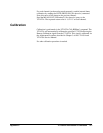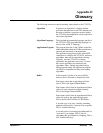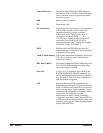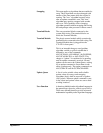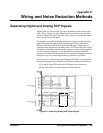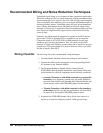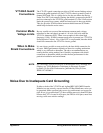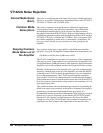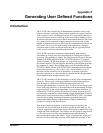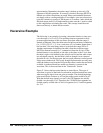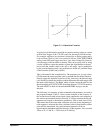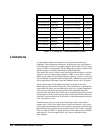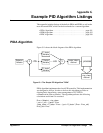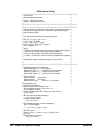
Wiring and Noise Reduction Methods 485Appendix E
VT1422A Guard
Connections
The VT1422A guard connection provides a 10 kΩ current limiting resistor
between the guard terminals (G) and VT1422A chassis ground for each 8
channel SCP bank. This is a safety device for the case where the Device
Under Test (DUT) isn't actually floating; the shield is connected to the DUT
and also connected to the VT1422A guard terminal (G). The 10 kΩ resistor
limits the ground loop current, which has been known to burn out shields.
This also provides 20 kΩ isolation between shields between SCP banks
which helps isolate the noise source.
Common Mode
Voltage Limits
Be very careful not to exceed the maximum common mode voltage
referenced to the card chassis ground of ±16 volts (±60 volts with the
VT1513A Attenuator SCP). There is an exception to this when high
frequency (1 kHz - 20 kHz) common mode noise is present (see “VT1422A
Noise Rejection” below). Also, if the DUT is not grounded, then the shield
should be connected to the VT1422A chassis ground.
When to Make
Shield Connections
It is not always possible to state positively the best shield connection for
all cases. Shield performance depends on the noise coupling mechanism
which is very difficult to determine. The above recommendations are
usually the best wiring method, but if feasible, experiment with shield
connections to determine which provides the best performance for the
particular installation and environment.
NOTE For a thorough, rigorous discussion of measurement noise, shielding and
filtering, see “Noise Reduction Techniques in Electronic Systems”
by Henry W. Ott of Bell Laboratories, published by Wiley & Sons,
ISBN 0-471-85068-3.
Noise Due to Inadequate Card Grounding
If either or both of the VT1422A and Agilent/HP E1482 (MXI Extender
Modules) are not securely screwed into the VXIbus Mainframe, noise can
be generated. Make sure that both screws (top and bottom) are screwed in
tight. If not, it is possible that CVT data could be more noisy than FIFO data
because the CVT is located in A24 space, the FIFO in A16 space; more lines
moving could cause noisier readings.



